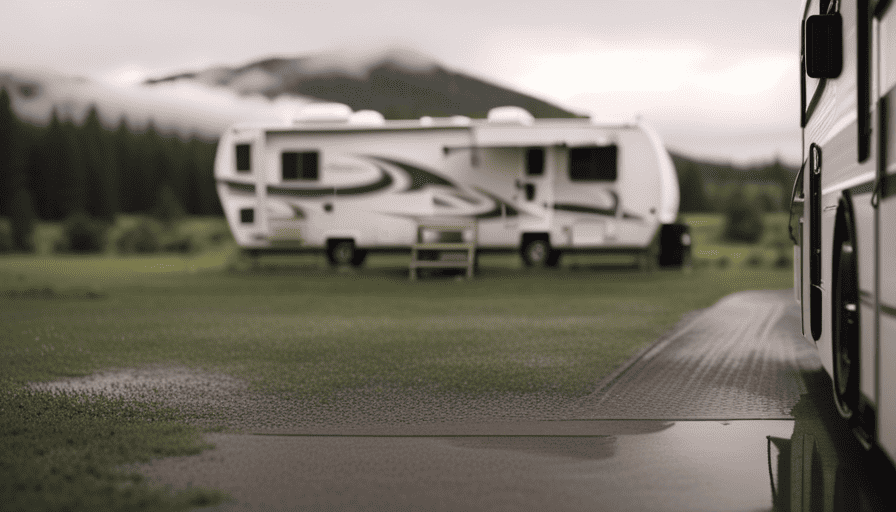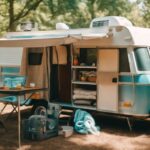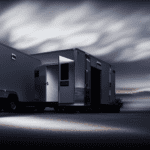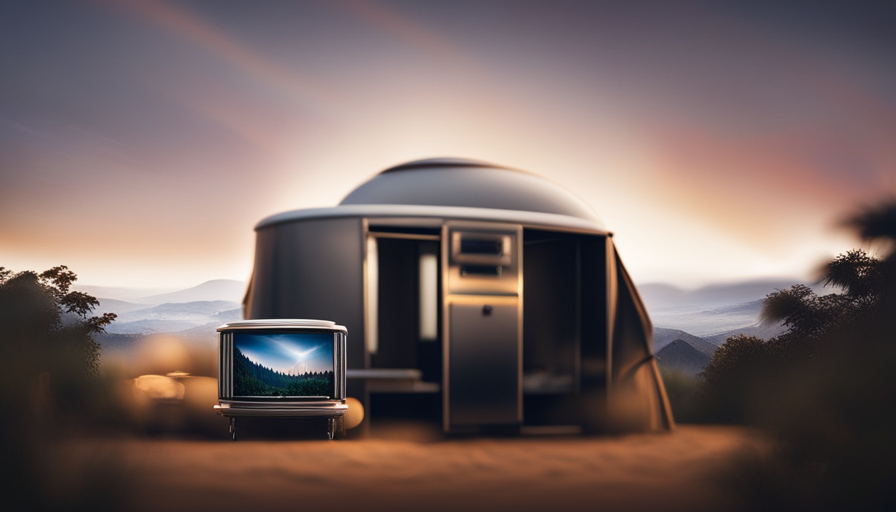You may be wondering, “It seems almost impossible to prevent moisture from getting into my camper.” But rest assured, it’s not as challenging as you may think.
With a little knowledge and some practical tips, you can ensure that your camper stays dry and comfortable, no matter the weather.
One of the biggest concerns when it comes to camper maintenance is keeping moisture at bay. Excess moisture can lead to mold and mildew growth, which can be both unsightly and unhealthy.
But fear not, because I’m about to share with you some tried and true methods for keeping the moisture out.
From identifying and fixing leaks to investing in waterproofing products, insulating properly, and using ventilation systems, there are plenty of steps you can take to create a dry and cozy living space in your camper.
So, let’s dive in and discover how to keep moisture out of your camper, so you can enjoy your travels to the fullest.
Key Takeaways
- Identify and fix leaks and water entry points immediately
- Use high-quality waterproofing products and sealants
- Properly insulate the camper using spray foam insulation, reflective foil insulation, and underbelly insulation
- Ensure proper ventilation by opening windows, using exhaust fans, and using moisture absorbers or desiccants
Identify and Fix Any Leaks or Water Entry Points
To prevent any further damage, it’s crucial to identify and fix any leaks or water entry points that may be causing moisture to seep into your camper. Identifying common leak sources is the first step in addressing this issue.
Start by inspecting the roof for any cracks, holes, or damaged seals. These are common areas where water can enter. Check the windows and doors as well, ensuring that the seals are intact and not allowing any water to seep through. Don’t forget to examine the exterior walls for any signs of leakage, such as discoloration or soft spots.
Once you’ve identified the potential leak sources, it’s time to take preventive measures against water entry. Repair any damaged seals or cracks immediately using appropriate sealants or caulking. Consider adding weather stripping to windows and doors for added protection. Additionally, applying a waterproofing agent to the exterior walls can help create a barrier against moisture.
By addressing any leaks or water entry points, you can significantly reduce the amount of moisture entering your camper. This will not only prevent further damage but also improve the overall comfort and air quality inside.
To further enhance moisture control, the next section will discuss the use of a dehumidifier or ventilation system.
Use a Dehumidifier or Ventilation System
Using a dehumidifier or ventilation system, can you effectively control the humidity inside your camper? Absolutely! These are two essential tools that can help keep moisture at bay and create a comfortable environment for your camping adventures.
Firstly, using a dehumidifier is a great way to remove excess moisture from the air. It works by extracting humidity and collecting it in a reservoir, preventing it from saturating the space. This simple device can significantly reduce the chances of mold and mildew growth, which can cause damage and health issues.
Secondly, installing a moisture sensor is another wise move. This sensor can detect high levels of humidity in your camper, alerting you to take action before any damage occurs. It can be connected to an app on your phone, allowing you to monitor the humidity levels remotely and make adjustments as needed.
By incorporating these tools into your camper, you can maintain a dry and comfortable environment. Investing in waterproofing products for your camper is the next step to ensure maximum protection against moisture intrusion.
Invest in Waterproofing Products for Your Camper
Make sure your camper stays dry and protected by investing in high-quality waterproofing products. Waterproofing techniques are essential for preventing moisture from entering your camper and causing damage.
Moisture prevention is crucial because it can lead to mold, mildew, and rot, which can be costly and difficult to repair. By using waterproofing products, you can create a barrier that keeps water out and ensures the longevity of your camper.
One effective waterproofing technique is to apply a water repellent spray or sealant to the exterior surfaces of your camper. These products create a protective layer that repels water and prevents it from seeping into the walls, roof, or windows. Additionally, you can use waterproofing agents on the seams and joints of your camper to further enhance its moisture resistance.
Another option is to invest in waterproof covers for your camper. These covers are specifically designed to protect your camper from rain, snow, and other elements. They’re made from durable, waterproof materials that provide a barrier against moisture. By using a waterproof cover, you can ensure that your camper remains dry even during heavy rain or snowfall.
Investing in waterproofing products is essential for keeping your camper dry and protected. By utilizing these techniques, you can prevent moisture from entering your camper and causing damage.
In the next section, I’ll discuss how to properly insulate your camper to further enhance its protection against the elements.
Properly Insulate Your Camper
Ensure that your camper stays well-insulated to protect it from the elements and maintain a comfortable living environment. Proper insulation is crucial for keeping moisture out and preventing the growth of mold and mildew. Here are some insulation techniques and energy-efficient options to consider:
-
Spray foam insulation: This type of insulation provides a seamless barrier that seals gaps and cracks, preventing air and moisture from entering your camper.
-
Reflective insulation: Reflective foil insulation can be installed in the walls, roof, and floor of your camper to reflect radiant heat and keep your living space cool in the summer and warm in the winter.
-
Insulated window coverings: Invest in thermal curtains or window shades to minimize heat transfer and keep your camper well-insulated.
-
Underbelly insulation: Insulating the underbelly of your camper can help prevent heat loss and keep moisture from seeping in through the floor.
By properly insulating your camper, you can create a barrier against moisture and maintain a comfortable interior. However, it’s also important to avoid excessive moisture inside by ventilating while cooking and showering. This will be discussed in the subsequent section.
Avoid Excessive Moisture Inside by Ventilating While Cooking and Showering
To prevent excessive moisture buildup inside your camper, it’s important to properly ventilate while cooking and showering. Ventilation plays a crucial role in maintaining a dry and comfortable environment inside your camper.
When you cook or take a shower, moisture is released into the air, and without proper ventilation, it can become trapped, leading to condensation and dampness. One of the main benefits of ventilation is that it allows the moist air to escape, preventing it from accumulating inside your camper.
Opening windows or using exhaust fans can help remove the humid air and replace it with fresh, dry air from outside. This exchange not only reduces moisture levels but also improves air quality, making your camper a healthier and more pleasant place to be.
In addition to ventilation, there are other moisture prevention techniques you can incorporate. Using a vent cover can help protect your camper from rain while still allowing for air circulation. Inspecting and repairing any leaks or cracks in the windows, doors, or roof can also prevent water from seeping in.
Furthermore, using moisture absorbers or desiccants can help remove excess moisture from the air, keeping your camper dry and mold-free.
By properly ventilating while cooking and showering and implementing other moisture prevention techniques, you can ensure that your camper remains a comfortable and moisture-free space.
Now, let’s explore how to use moisture absorbers or desiccants to further enhance moisture control within your camper.
Use Moisture Absorbers or Desiccants
Keep your camper dry and comfortable by using moisture absorbers or desiccants. These will help to remove excess humidity from the air and create a more pleasant environment for you to relax in.
Moisture absorbing materials, such as silica gel packets or activated charcoal, are highly effective in preventing moisture buildup inside your camper. These materials work by absorbing moisture from the air, reducing the humidity level, and preventing the growth of mold and mildew.
Silica gel packets are commonly used as moisture absorbers due to their high absorption capacity. You can place these packets in areas prone to moisture, such as closets, cabinets, or under the sink. They are also great for absorbing moisture inside your camper’s storage compartments. Another option is using activated charcoal, which not only absorbs moisture but also helps to eliminate odors.
To effectively prevent moisture, make sure to replace or recharge the moisture absorbers regularly, as they can become saturated over time. This will ensure continuous moisture absorption and maintain a dry environment inside your camper.
By using moisture absorbers or desiccants, you can significantly reduce the risk of condensation and moisture-related problems in your camper. With these effective moisture prevention techniques, you can enjoy a comfortable and dry camping experience.
Now, let’s move on to the next section about keeping windows and doors sealed tight to further protect against moisture infiltration.
Keep Windows and Doors Sealed Tight
Sealing your windows and doors tightly is crucial for maintaining a dry and comfortable environment inside your camper. Imagine being on a camping trip during a heavy rainstorm and having a perfectly sealed camper, with no leaks or drafts, allowing you to relax and enjoy the sound of rain without any worries about water seeping in.
Properly sealed windows and doors offer numerous benefits. Firstly, they prevent moisture from entering your camper, keeping it dry and mold-free. Moisture can lead to the growth of mold and mildew, which not only cause unpleasant odors but also pose a health risk. Additionally, sealing your windows and doors helps to maintain a consistent temperature inside the camper, keeping it warm in the winter and cool in the summer. This can significantly improve your camping experience.
When sealing windows and doors, it’s important to avoid common mistakes. One of the most common errors is using low-quality weatherstripping or caulking materials. Investing in high-quality products ensures a proper seal that will last longer. Another mistake is neglecting to clean and prepare the surfaces before applying the sealant. Dirt and debris can prevent the sealant from adhering properly, compromising its effectiveness.
With windows and doors tightly sealed, you can enjoy a dry and comfortable camper, even during rainy days. Now that we’ve discussed the benefits of proper sealing and common mistakes to avoid, let’s move on to the next step: removing wet items and drying them outside of the camper.
Remove Wet Items and Dry Them Outside of the Camper
Make sure you take out any wet items and dry them outside of the camper to prevent any dampness or mold from spreading inside. Drying wet items properly is essential in keeping moisture out of your camper and preventing the growth of mildew. Here are some effective drying techniques that you can use:
-
Hang clothes and towels on a clothesline: Hang them outside in the sunlight and fresh air to allow them to dry thoroughly.
-
Use a dehumidifier: If you have access to electricity, using a dehumidifier inside your camper can help remove excess moisture from the air and aid in drying wet items.
-
Utilize a portable fan: Place a fan near wet items to increase air circulation and speed up the drying process.
-
Use absorbent materials: Place absorbent materials, such as towels or newspaper, under wet items to soak up excess moisture.
-
Open windows and vents: Opening windows and vents can help facilitate airflow and aid in drying wet items.
By following these drying techniques, you can effectively remove moisture from your camper and prevent the growth of mold. Once you have dried your items, it is important to regularly clean and maintain your camper to prevent mold growth.
Regularly Clean and Maintain Your Camper to Prevent Mold Growth
Regularly cleaning and maintaining your camper is crucial in preventing the growth of mold and ensuring a healthy living environment. Mold thrives in damp and humid conditions, making campers particularly susceptible to its growth. To keep your camper mold-free, it’s important to take preventive measures and implement effective cleaning techniques.
Start by inspecting your camper regularly for any signs of moisture or leaks. Check for water stains on walls, ceilings, or floors, as these are indicators of potential mold growth. Repair any leaks promptly to prevent further damage and mold development. Additionally, make sure your camper is properly ventilated to reduce humidity levels.
When cleaning your camper, use a mild detergent or a mixture of vinegar and water to remove dirt and grime. Pay special attention to areas prone to moisture, such as the bathroom, kitchen, and storage compartments. Scrub surfaces thoroughly, including walls, floors, and furniture. Dry these areas completely after cleaning to prevent lingering moisture.
Regularly clean and dry your camper’s bedding, curtains, and upholstery, as they can easily trap moisture and promote mold growth. Consider using moisture-absorbing products, such as dehumidifiers or moisture control packets, to further combat humidity inside your camper.
By regularly cleaning and maintaining your camper, you can prevent mold growth and promote a healthy living environment. Taking these preventive measures and using effective cleaning techniques will help keep moisture out of your camper. Consider using a moisture barrier or moisture control products to further protect your camper from moisture-related issues.
Consider Using a Moisture Barrier or Moisture Control Products
Using a moisture barrier or moisture control products can help safeguard your camper, ensuring a healthy and mold-free sanctuary for you and your loved ones.
Moisture barrier installation is an effective way to keep moisture out of your camper. These barriers are typically made of materials such as plastic or aluminum foil and are installed between the ground and the bottom of the camper. They create a barrier that prevents moisture from seeping into the camper through the floor. When installing a moisture barrier, it’s important to ensure that it’s properly sealed and covers the entire area underneath the camper.
In addition to moisture barriers, there are also various moisture control products available on the market. These products are designed to absorb excess moisture and help maintain a dry environment inside the camper. Some common moisture control products include dehumidifiers, moisture absorbers, and ventilation systems. When selecting moisture control products, it’s important to consider the size of your camper and the level of moisture present. It’s also important to regularly check and maintain these products to ensure their effectiveness.
By utilizing a moisture barrier and moisture control products, you can effectively keep moisture out of your camper and prevent the growth of mold and mildew. This will not only help maintain a healthy environment but also protect the structural integrity of your camper. So, invest in these preventive measures and enjoy a mold-free camping experience.
Frequently Asked Questions
Can I use a regular fan as a ventilation system in my camper?
Sure, you can definitely use a regular fan as a ventilation system in your camper. However, it may not be as effective as using dehumidifiers or installing vents specifically designed for campers. While a fan can help circulate air and reduce humidity to some extent, it may not be enough to completely prevent moisture buildup. To ensure proper ventilation and moisture control, it’s recommended to invest in dehumidifiers or install vents designed for campers.
Are there any specific waterproofing products you recommend for campers?
For waterproofing techniques and best practices for camper maintenance, I recommend using a combination of products.
Start by applying a waterproof sealant to all external seams, windows, and doors. This will create a barrier against moisture.
Additionally, use a moisture absorber inside the camper to reduce humidity levels. Ensure proper ventilation by installing vent covers and using a dehumidifier if necessary.
Regularly inspect and maintain the camper’s roof and caulking to prevent water leaks.
How do I properly insulate my camper?
Proper camper insulation is crucial for maintaining a comfortable and cozy interior. To achieve this, there are various techniques you can employ.
Start by insulating the walls and ceiling using materials like foam board or fiberglass insulation. Seal any gaps or cracks with caulk to prevent drafts.
Don’t forget to insulate the windows and doors as well.
By paying attention to these details, you can create a well-insulated camper that’ll keep you warm during chilly nights and cool during hot summers.
What are some common mistakes people make when ventilating while cooking and showering?
Common ventilation misconceptions while cooking and showering include the belief that opening a window is sufficient to control moisture, or that using a bathroom fan is enough. However, these methods often fall short. To effectively control moisture in a camper, it’s important to use a range hood or vent above the stove to remove cooking steam. Additionally, a bathroom vent with an external exhaust should be used to remove shower humidity. These measures will help prevent condensation and keep your camper dry.
How often should I clean and maintain my camper to prevent mold growth?
Cleaning and maintaining your camper regularly is crucial in preventing mold growth. Did you know that mold can start growing within 24 to 48 hours in the right conditions?
To keep mold at bay, it’s recommended to clean your camper at least once a month. Wipe down all surfaces with a mildew-resistant cleaner, paying special attention to areas prone to moisture, such as the bathroom and kitchen.
Additionally, make sure to check and repair any leaks or areas of potential water intrusion.
Conclusion
So there you have it, folks! By following these simple yet effective tips, you can keep moisture out of your camper and enjoy your adventures without any damp surprises.
Remember, just like a well-oiled machine, your camper also needs regular maintenance and care to ensure it stays in top-notch condition. So don’t let moisture rain on your parade, take action now and keep your camper dry as a desert. Happy camping!



















